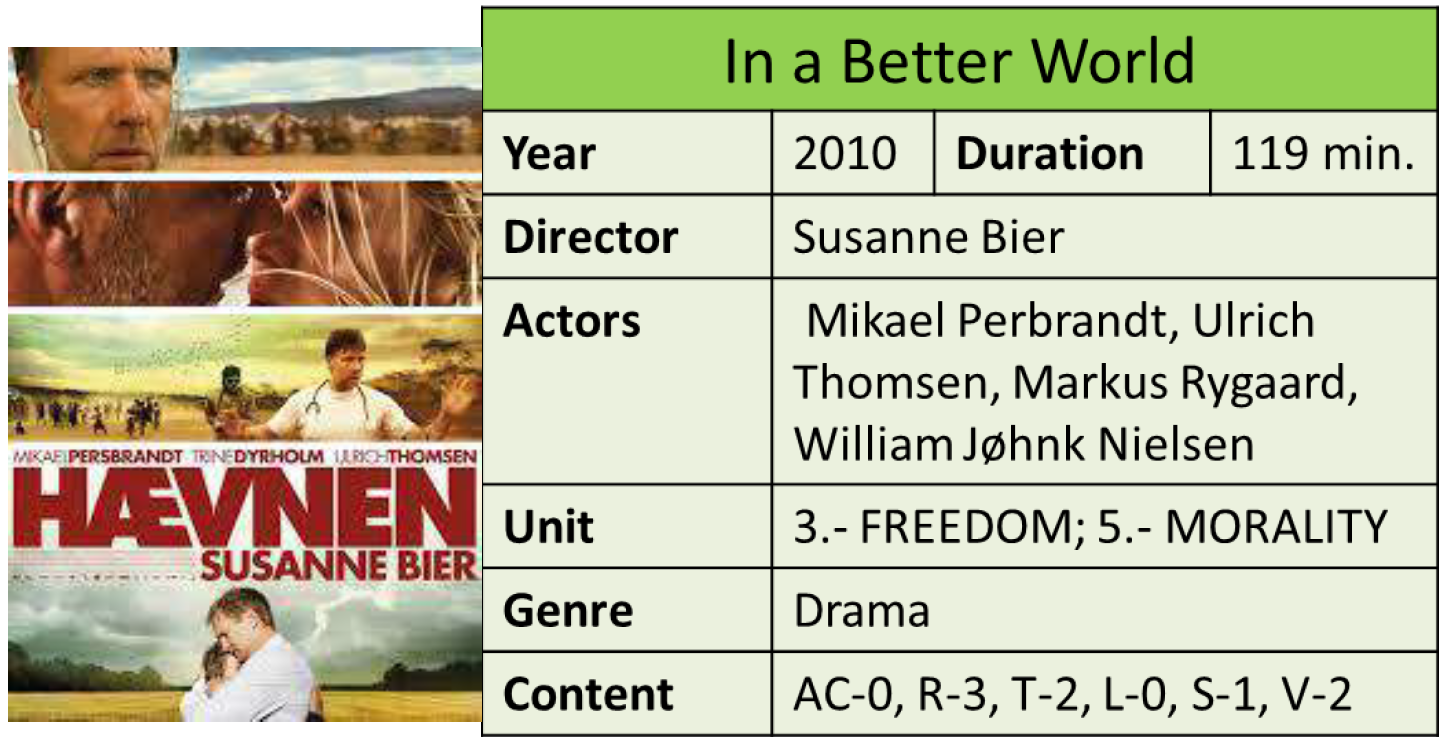Movie references
In a Better World


Plot summary

“In a BetterWorld” centers around two children and their respective families.
- Claus (Ulrich Thomsen), a widower, and Christian (William Jøhnk Nielsen). A broken family that
recently arrived from London after losing their mother to a very painful form of cancer. Christian
hasn’t gotten over the loss. - Anton (Mikel Persbrandt), Marianne (Trine Dyrholm) and their two sons: Elias (Markus Rygaard),
10 years old, and another younger boy. They are separated and considering the possibility of
divorce.
Elias is picked on by his classmates at school, until he receives some unexpected help from
Christian, who threatens the class’s head bully with a knife to get him to leave Elias alone.
A little while later, Elias’s father, Anton, a committed doctor who practices in Third World countries, comes to visit and is attacked by an lunatic in front of the boys. He opts to ignore him and not to fight back. Elias, and to a greater extent Christian, don’t understand the doctor’s position, and a great tragedy is unleashed.
Themes to discuss
1.- Responding to violence: revenge or forgiveness
“In a Better World” shows us two broken families: one from cancer, and the other from divorce, who are both crying out for a second chance. We see one boy who is angry with life and willing to avenge injustices, and another who is more inclined to bottle up the blows that he receives. We also see a father willing to be brave without behaving like an idiot who resorts to force, and a society that must learn to forgive in order to believe in a better world.
Susanne Bier offers a profound reflection on man’s response to violence and on the dichotomy that exists between good judgment and chaos. She doesn’t scrimp on difficult emotional scenes, especially when it comes to an African leader who systematically uses a knife to cut open the wombs of pregnant mothers…
In any case, it is understood that her characters are tempted by the possibility of revenge; rationality, the more civilized route, is more difficult to put into practice and comes with its
problems as well, since sometimes it means that the aggressor can continue to pursue his activities…
Bier takes out a magnifying glass and observes the phenomenon of revenge: in front of evil
inflicted for no good reason the law of “an eye for an eye” seems to be justified. Before this type of Logic, Anton, the father of Elias, embodies a secular version of “offering the other cheek”. He is not a mere pacifist; rather, he is sure that violence neither changes, nor improves or builds anything. And this attitude is judged as cowardly by the two boys. What is interesting is that, in the past, Anton also caused his wife immense, unjustified pain, and he is only hoping for forgiveness.
This establishes the film’s dramatic tension between rightful revenge and the ever-unpredictable gratuity of forgiveness. The proposal is positive, though precarious, and leaves the bittersweet sensation that this human forgiveness is a short path. Despite its hopeful ending, the audience can take home the dull roar of a tsunami of evil. The thing is that forgiveness is something of a different world.
This film offers no response to the moral dilemmas that it lays out; rather, it seems to have wanted to leave the door open for reflection. Bier offers a very atrocious vision of the world, and like all her work, this is a tear-jerker. The director brings a certain optimism, betting on man’s capacity for redemption against all odds.
2.- Two worlds
Just like in AFTER THE WEDDING (2006), which was nominated for an Oscar for best foreign film, Susanne Bier likes to juxtapose the realities of two worlds that are light-years apart: that of opulent Western society and the impoverished Third World in the form of a refugee camp (in the 2006 film it was an orphanage in India). She does this in order to demonstrate that both worlds are not quite so separate when it comes to the violence that flourishes in them both.
3.- The destruction of the family
In the part of the film that shows the opulent Western world, there are family conflicts and a lack of family stability which end up pushing innocent children to join in a cycle of violence that reaches dangerous and surprising levels. One of the worst consequences is the hindrance of communication between father and son.